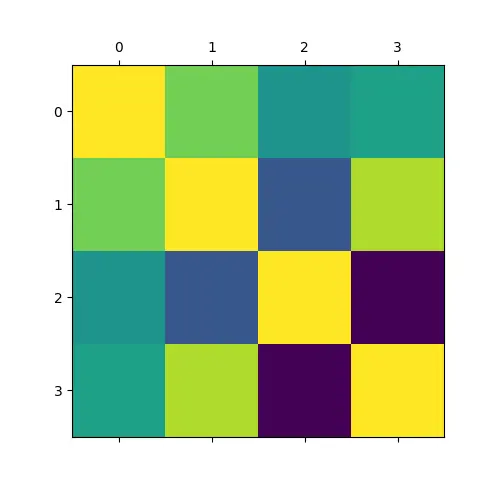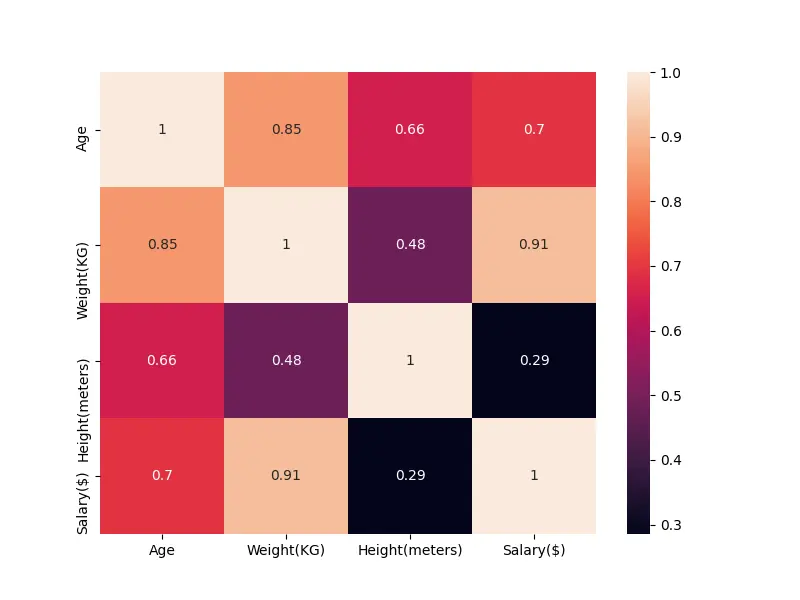Pandas 相关矩阵
Suraj Joshi
2024年2月15日
Pandas
-
使用
DataFrame.corr()方法生成相关矩阵 -
使用
Matplotlib.pyplot.matshow()方法可视化 Pandas 相关矩阵 -
使用
seaborn.heatmap()方法可视化 Pandas 相关矩阵 -
使用
DataFrame.style属性可视化相关矩阵

本教程将解释我们如何使用 DataFrame.corr() 方法生成相关矩阵,并使用 Matplotlib 中的 pyplot.matshow() 方法将相关矩阵可视化。
import pandas as pd
employees_df = pd.DataFrame(
{
"Name": ["Jonathan", "Will", "Michael", "Liva", "Sia", "Alice"],
"Age": [20, 22, 29, 20, 20, 21],
"Weight(KG)": [65, 75, 80, 60, 63, 70],
"Height(meters)": [1.6, 1.7, 1.85, 1.69, 1.8, 1.75],
"Salary($)": [3200, 3500, 4000, 2090, 2500, 3600],
}
)
print(employees_df, "\n")
输出:
Name Age Weight(KG) Height(meters) Salary($)
0 Jonathan 20 65 1.60 3200
1 Will 22 75 1.70 3500
2 Michael 29 80 1.85 4000
3 Liva 20 60 1.69 2090
4 Sia 20 63 1.80 2500
5 Alice 21 70 1.75 3600
我们将使用 DataFrame employees_df 来解释如何生成和可视化相关矩阵。
使用 DataFrame.corr() 方法生成相关矩阵
import pandas as pd
employees_df = pd.DataFrame(
{
"Name": ["Jonathan", "Will", "Michael", "Liva", "Sia", "Alice"],
"Age": [20, 22, 29, 20, 20, 21],
"Weight(KG)": [65, 75, 80, 60, 63, 70],
"Height(meters)": [1.6, 1.7, 1.85, 1.69, 1.8, 1.75],
"Salary($)": [3200, 3500, 4000, 2090, 2500, 3600],
}
)
print("The DataFrame of Employees is:")
print(employees_df, "\n")
corr_df = employees_df.corr()
print("The correlation DataFrame is:")
print(corr_df, "\n")
输出:
The DataFrame of Employees is:
Name Age Weight(KG) Height(meters) Salary($)
0 Jonathan 20 65 1.60 3200
1 Will 22 75 1.70 3500
2 Michael 29 80 1.85 4000
3 Liva 20 60 1.69 2090
4 Sia 20 63 1.80 2500
5 Alice 21 70 1.75 3600
The correlation DataFrame is:
Age Weight(KG) Height(meters) Salary($)
Age 1.000000 0.848959 0.655252 0.695206
Weight(KG) 0.848959 1.000000 0.480998 0.914861
Height(meters) 0.655252 0.480998 1.000000 0.285423
Salary($) 0.695206 0.914861 0.285423 1.000000
它生成一个 DataFrame,其中包含 DataFrame 中每一列与其他列之间的相关值。
相关值只在有数值的列之间计算。默认情况下,corr() 方法使用 Pearson 方法来计算相关系数。我们也可以通过在 corr 方法中指定 method 参数的值,使用其他方法如 Kendall 和 spearman 来计算相关系数。
使用 Matplotlib.pyplot.matshow() 方法可视化 Pandas 相关矩阵
import pandas as pd
import matplotlib.pyplot as plt
employees_df = pd.DataFrame(
{
"Name": ["Jonathan", "Will", "Michael", "Liva", "Sia", "Alice"],
"Age": [20, 22, 29, 20, 20, 21],
"Weight(KG)": [65, 75, 80, 60, 63, 70],
"Height(meters)": [1.6, 1.7, 1.85, 1.69, 1.8, 1.75],
"Salary($)": [3200, 3500, 4000, 2090, 2500, 3600],
}
)
corr_df = employees_df.corr(method="pearson")
plt.matshow(corr_df)
plt.show()
输出:

它使用 Matplotlib.pyplot 中的 matshow() 函数绘制从 employees_df DataFrame 生成的相关矩阵。
使用 seaborn.heatmap() 方法可视化 Pandas 相关矩阵
import pandas as pd
import seaborn as sns
import matplotlib.pyplot as plt
employees_df = pd.DataFrame(
{
"Name": ["Jonathan", "Will", "Michael", "Liva", "Sia", "Alice"],
"Age": [20, 22, 29, 20, 20, 21],
"Weight(KG)": [65, 75, 80, 60, 63, 70],
"Height(meters)": [1.6, 1.7, 1.85, 1.69, 1.8, 1.75],
"Salary($)": [3200, 3500, 4000, 2090, 2500, 3600],
}
)
corr_df = employees_df.corr(method="pearson")
plt.figure(figsize=(8, 6))
sns.heatmap(corr_df, annot=True)
plt.show()
输出:

它使用 seaborn 包中的 heatmap() 函数绘制从 employees_df DataFrame 生成的相关矩阵。
使用 DataFrame.style 属性可视化相关矩阵
import pandas as pd
employees_df = pd.DataFrame(
{
"Name": ["Jonathan", "Will", "Michael", "Liva", "Sia", "Alice"],
"Age": [20, 22, 29, 20, 20, 21],
"Weight(KG)": [65, 75, 80, 60, 63, 70],
"Height(meters)": [1.6, 1.7, 1.85, 1.69, 1.8, 1.75],
"Salary($)": [3200, 3500, 4000, 2090, 2500, 3600],
}
)
corr_df = employees_df.corr(method="pearson")
corr_df.style.background_gradient(cmap="coolwarm")
输出:

corr_df DataFrame 对象的 style 属性返回一个 Styler 对象。我们可以使用 Styler 对象的 background_gradient 来可视化 DataFrame 对象。
本方法只能在 IPython 中生成图形。
Enjoying our tutorials? Subscribe to DelftStack on YouTube to support us in creating more high-quality video guides. Subscribe
作者: Suraj Joshi
Suraj Joshi is a backend software engineer at Matrice.ai.
LinkedIn